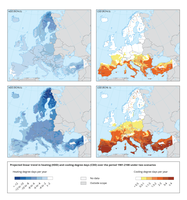
This database contain policies and measures (PaMs) reported by EU Member States following European Commission Implementing Decision (EU) 2018/1522 of 11 October 2018 laying down a common format for national air pollution control programmes under Directive (EU) 2016/2284 of the European Parliament and of the Council on the reduction of national emissions of certain atmospheric pollutants.

Potential quiet areas in Europe, based upon Quietness Suitability Index (QSI) and Natura 2000 protected areas

Northward shift of agro-climate zones in Europe analysed over the past 40 years and under future climate conditions for the next decades.

These maps show the trend in heating degree days (left) and cooling degree days (right) from 1981-2100 for all EEA member and cooperating countries, based on the median of an ensemble of 11 EURO-CORDEX simulations.

These maps show observed linear trends in heating degree days (left) and cooling degree days (right) over 1981–2017 for all EEA member and cooperating countries. Stippling depicts regions where the trend is statistically significant at the 5% level.

This map shows bathing water locations and their quality for the latest as well as previous bathing seasons. All symbols are coloured according to achieved quality status in the most recent season. Data are presented on two levels: country (less detailed scales) and bathing water (more detailed scales).

Results of classification of Chemical Status using the CHASE+ tool. Chemical status is evaluated in five classes, where NPAhigh and NPAgood are recognised as ‘non-problem areas’ and PAmoderate, PApoor and PAbad are recognised as ‘problem areas’ .

Results of classification of Chemical Status using the CHASE+ tool. Chemical status is evaluated in five classes, where NPAhigh and NPAgood are recognised as ‘non-problem areas’ and PAmoderate, PApoor and PAbad are recognised as ‘problem areas’ .

Results of classification of Chemical Status using the CHASE+ tool. Chemical status is evaluated in five classes, where NPAhigh and NPAgood are recognised as ‘non-problem areas’ and PAmoderate, PApoor and PAbad are recognised as ‘problem areas’.

Results of classification of Chemical Status using the CHASE+ tool. Chemical status is evaluated in five classes, where NPAhigh and NPAgood are recognised as ‘non-problem areas’ and PAmoderate, PApoor and PAbad are recognised as ‘problem areas’.
Document Actions
Share with others